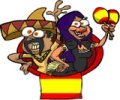Learn Spanish Verbs
| If you are learning Spanish, I have something you will need and WANT to Learn Spanish VERBS |
|---|
|
Our way of teaching the Spanish Verbs is totally new, totally fresh, totally radical, and supremely easier than any previous methods. Never been taught this way before... Of course 200 Words a Day! users will know that our secrets are not really secrets. And they really work. The Memory Masters teach us that the best way to remember something is to visualise it in a crazy, zany scene. The more zany, the easier it is to recall. So with the award winning 200 Words a Day! system every concept has a Memory Trigger, a cartoon and a way of remembering what you learn, and recalling it when you need it. This way you can learn 5 times more than using traditional learning methods.... (in fact more than 5 times quicker!) How do we do this? So how we address the 14 tenses of Spanish is simple.
Let's assume you want to say, I WILL TALK. We take the tense, that is the WILL bit. We give the tense (WILL) a CHARACTER. In this case we use Prince WILL-iam who WILL be King. OK, now for the second part WILL the CHARACTER has an ACTION which will remind us of the endings of the verb. Now the endings in Spanish for the WILL family of tense conjugations sound a bit like RAY. yo hablare (HABLA-REY) - I will talk. So because the endings are RAY - RAS - RA - REMOS - RAIS - RAN... They sound a bit like RAY. We give WILL an action to remind us of the endings, a Memory Trigger - a RAY gun in this case, and his pet sting RAY. Once you know the general ending concept, you can determine the others by remembering the patterns. That should be enough, but we go a little further. And we have a whole cartoon to remind you of the PATTERN. In this case we have Prince WILL and his Sting RAY and we make this in to a silly cartoon to help you remember. It is a cartoon of Prince Will and his sting-RAY, who is a RASTA RAY, named REMUS who RACE RAN. i.e he RAN a RACE. Sounds like a mouthful but check out the cartoon picture and you will remember most of it easily. And as long as you remember a bit of it, there are other triggers in there that link you to the other bits. By remembering this you will remember the concept and the patterns of endings of the entire conjugation. All the other 13 conjugations also have such cartoons, as do the useful phrases like:
Anyway, that is it for now, I shall return to talk more about the verbs course very soon. |
The 200 Words a Day team is very busy in the development of the 'Learn Spanish Verbs' course which will be a revolutionary advance in the way Spanish verbs are taught and learned.
Using the same fundamental techniques that are the basis of the 200 Words a Day! courses, we are in the advanced stages of programming and artwork for this course.
Spanish verbs are definitely the most difficult thing to learn when learning Spanish.
- Firstly there are lots and lots of them.
- There are literally hundreds of different endings that are used, making the learning of Spanish verbs quite a big job.
- Spanish speakers drop the pronouns when speaking, making it difficult for the new learner to know instantly which person and tense they are talking about. We'll talk more about this below, but in essence whereas we would say, "I go to the store and He goes to the store," the Hispanic would say,"Go to the store and goes to the store." Notice how the endings of 'go' are different. In English the only pronouns that match with 'goes is he, she or it. In Spanish every pronoun has a different ending so that there are six different unique endings for each personal pronoun. So because of this they drop the I, you, he, she, they, we and it because the unique endings of the verbs tell the listener who it is the speaker is referring to. Makes sense but it makes it tricky for the learner.
- The endings change for the personal pronouns for each and every different Spanish verb tense. This makes over 100 basic endings!
- There are also more pronouns! The Spanish have four ways to say 'YOU'. tú: Informal to one person. Used for people you know well like family and friends, or used when a adult speaks to an child. vosotros: Informal to more than one person. This is the plural of tú. (This form is not generally used in Latin American Spanish). usted: Formal to one person. Used for people you do not know well, your superiors, and is the polite form. ustedes: Formal to more than one person. This is the plural of usted.
- The Spanish have two ways to say 'we', they and you plural, for the masculine and feminine cases. nosotros: 'we' male, or mixed male and female group. nosotras: 'we' for a group of females. vosotros: 'you' plural informal for masculine or mixed group. vosotras: 'you' plural informal for female group ellos: 'they' for males or mixed group. ellas: 'they' for females.
- But - before you give up, help is at hand. It is like a eating an elephant (a mythical elephant). You can only do it bit by bit. You learn each of the 18 or so patterns, one at a time. You can also then learn the commonly used phrases - like: I was going to...... I had been going..... I am going to....... etc, etc We are developing the 'Learn Spanish Verbs' course which will teach Spanish verbs using the fun, Memory Masters techniques that have made the 200 Words a Day such an easy way to build Spanish vocab and phrases.
In the meantime, while you let us toil away at our hot computers getting the 'Learn Spanish Verbs' programme ready for you, you can subscribe to the free Spanish lessons which include a number of Spanish Verbs courses.
Home | 200 Words a Day Info |
Spanish |
French | German | Order It Here |
Features |
How the Courses Developed |
Newsletter Ezine |
About Us |
Spanish Pics |
Spanish Lessons |
Testimonials |
Contact Us
200 Words a Day! and Exceltra
©Copyright
2004-2023 All Rights Reserved
IMAGINE how you'd
FEEL
seeing yourself learning at a rate of 200 words a day ... the ideal companion course that complements any language course.
|










New! Comments
Have your say about what you just read! Leave us a comment in the box below.